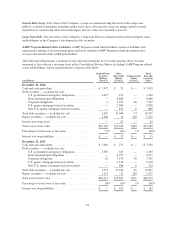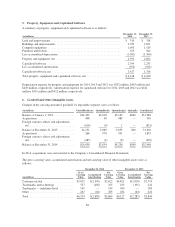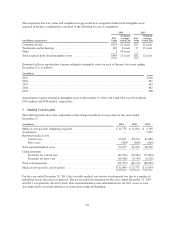United Healthcare 2014 Annual Report Download - page 92
Download and view the complete annual report
Please find page 92 of the 2014 United Healthcare annual report below. You can navigate through the pages in the report by either clicking on the pages listed below, or by using the keyword search tool below to find specific information within the annual report.
A reconciliation of the beginning and ending amount of unrecognized tax benefits as of December 31 is as
follows:
(in millions) 2014 2013 2012
Gross unrecognized tax benefits, beginning of period ................................ $89 $81 $129
Gross increases:
Current year tax positions .................................................. — 8 6
Prior year tax positions .................................................... 4 5 18
Gross decreases:
Prior year tax positions .................................................... — — (48)
Settlements ............................................................. — — (10)
Statute of limitations lapses ................................................ (1) (5) (14)
Gross unrecognized tax benefits, end of period ..................................... $92 $89 $ 81
The Company classifies interest and penalties associated with uncertain income tax positions as income taxes
within its Consolidated Financial Statements. During 2014 and 2013, the Company recognized $6 million and $4
million of interest expense, respectively. The Company recognized tax benefits from the net reduction of interest
and penalties accrued of $20 million during the year ended December 31, 2012. The Company had $33 million
and $27 million of accrued interest and penalties for uncertain tax positions as of December 31, 2014 and 2013,
respectively. These amounts are not included in the reconciliation above. As of December 31, 2014, the total
amount of unrecognized tax benefits that, if recognized, would affect the effective tax rate, was $92 million.
The Company currently files income tax returns in the United States, various states and non-U.S. jurisdictions.
The U.S. Internal Revenue Service (IRS) has completed exams on the consolidated income tax returns for fiscal
years 2013 and prior. The Company’s 2014 tax year is under advance review by the IRS under its Compliance
Assurance Program. With the exception of a few states, the Company is no longer subject to income tax
examinations prior to the 2007 tax year. The Brazilian federal revenue service — Secretaria da Receita Federal
(SRF) may audit the Company’s Brazilian subsidiaries for a period of five years from the date on which
corporate income taxes should have been paid and/or the date when the tax return was filed. Estimated taxes are
paid monthly in Brazil with an annual return due on June 30 following the end of the taxable year.
The Company believes it is reasonably possible that its liability for unrecognized tax benefits will decrease in the
next twelve months by $39 million as a result of audit settlements and the expiration of statutes of limitations in
certain major jurisdictions.
10. Shareholders’ Equity
Regulatory Capital and Dividend Restrictions
The Company’s regulated subsidiaries are subject to regulations and standards in their respective jurisdictions.
These standards, among other things, require these subsidiaries to maintain specified levels of statutory capital,
as defined by each jurisdiction, and restrict the timing and amount of dividends and other distributions that may
be paid to their parent companies. In the United States, most of these regulations and standards are generally
consistent with model regulations established by the National Association of Insurance Commissioners. These
standards generally permit dividends to be paid from statutory unassigned surplus of the regulated subsidiary and
are limited based on the regulated subsidiary’s level of statutory net income and statutory capital and surplus.
These dividends are referred to as “ordinary dividends” and generally can be paid without prior regulatory
approval. If the dividend, together with other dividends paid within the preceding twelve months, exceeds a
specified statutory limit or is paid from sources other than earned surplus, it is generally considered an
“extraordinary dividend” and must receive prior regulatory approval.
For the year ended December 31, 2014, the Company’s regulated subsidiaries paid their parent companies
dividends of $4.6 billion, including $1.5 billion of extraordinary dividends. For the year ended December 31,
90
























